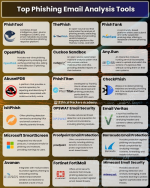-
To ensure you get the most out of your CIN membership and stay connected with the latest updates, we are asking all members to update their community profiles. Please take a few moments to log in and: • Complete all sections of your profile • Review your current information for accuracy • Enter an alternative email address if desired (CIN requires your valid business email address for your training organization). Keeping your profile up to date helps us better serve you, ensures your account is correctly linked with CompTIA’s CRM, streamlines processes, enhances communication, and guarantees you never miss out on valuable CIN opportunities. Thank you for taking this important step! step!
You are using an out of date browser. It may not display this or other websites correctly.
You should upgrade or use an alternative browser.
You should upgrade or use an alternative browser.
Phishing Email Analysis Tools
- Thread starter Trevor Chandler
- Start date
Spotting shady links and emails before they can reel you in.
precious, how do you go about spotting shady links? How do you go about spotting shady emails?Spotting shady links and emails before they can reel you in.
Thank you for sharing
Of course not always accurate like the tools you provided, when it comes to dubious web addresses, I must say they are just like spam email. If the web address is overly conspicuous or tempting or urges me to 'BE THE FIRST TO CLICK', I just ignore it.precious, how do you go about spotting shady links? How do you go about spotting shady emails?
You won't be failing an phishing assessments!!!Of course not always accurate like the tools you provided, when it comes to dubious web addresses, I must say they are just like spam email. If the web address is overly conspicuous or tempting or urges me to 'BE THE FIRST TO CLICK', I just ignore it.
Yes exactly.You won't be failing an phishing assessments!!!
Hahaha! Thanks! Funny though enough, even a college professor once fell so hard for a Nigerian prince scam that he drained his savings and even stole from the university to pay the scammers. When the FBI got involved, he accused them of trying to steal his 'millions.' Goes to show, anyone can slip up without awareness!You won't be failing an phishing assessments!!!
Wait until you get some in your inboxYes exactly.
How about python regression models.
import pandas as pd
import numpy as np
df = pd.read_csv('../datasets/sms_spam_perceptron.csv')
X = df.iloc[:, [1, 2]].values
y = df.iloc[:, 0].values
y = np.where(y == 'spam', -1, 1)
from sklearn.linear_model import LinearRegression
linear_regression = LinearRegression()
linear_regression.fit(X,y)
print (linear_regression.score(X,y))
import pandas as pd
import numpy as np
df = pd.read_csv('../datasets/sms_spam_perceptron.csv')
X = df.iloc[:, [1, 2]].values
y = df.iloc[:, 0].values
y = np.where(y == 'spam', -1, 1)
from sklearn.linear_model import LinearRegression
linear_regression = LinearRegression()
linear_regression.fit(X,y)
print (linear_regression.score(X,y))
This expression is interesting but I need the person that can interpret it for me.How about python regression models.
import pandas as pd
import numpy as np
df = pd.read_csv('../datasets/sms_spam_perceptron.csv')
X = df.iloc[:, [1, 2]].values
y = df.iloc[:, 0].values
y = np.where(y == 'spam', -1, 1)
from sklearn.linear_model import LinearRegression
linear_regression = LinearRegression()
linear_regression.fit(X,y)
print (linear_regression.score(X,y))

